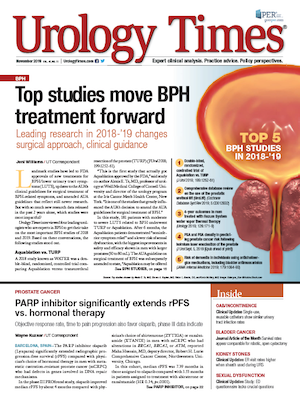Publication
Article
Urology Times Journal
ER visit rates higher when sheath used during URS
Author(s):
A study presented at the AUA annual meeting in Chicago shows higher rates of emergency department (ED) visits when ureteral access sheaths are used during ureteroscopy to remove kidney stones.
Chicago-A study presented at the AUA annual meeting in Chicago shows higher rates of emergency department (ED) visits when ureteral access sheaths are used during ureteroscopy to remove kidney stones.
Ureteral access sheaths represent a major advance in ureteroscopy due to the ease with which urologists can remove multiple kidney stones from the ureter without having to reintroduce guidewires into the urethra. But the use of sheaths is not without risk, cost, and operating room time, and opinions regarding which patients are ideal candidates for this procedure vary.
Researchers from the Michigan Urological Surgery Improvement Collaborative (MUSIC)-a physician-led quality improvement collaborative comprising a consortium of urology practices across Michigan-sought to determine the impact of the use of ureteral access sheaths on surgical complications. They also examined whether the use of sheaths led to an increase in surgical complications.
Using the MUSIC Reducing Operative Complications from Kidney Stones (MUSIC ROCKS) registry, the authors identified patients who underwent ureteroscopy using a ureteral access sheath between June 2016 and July 2018. Then, they examined data related to the use of ureteral access sheaths during ureteroscopy, complications resulting from these procedures, readmission rates, and ED visits.
Among the 5,316 ureteroscopies performed across the state, ureteral access sheaths were used in more than one-third of cases, from ureteral stones (nearly 40% of cases involving ureteral access sheaths) to renal stones (about 47%). The frequency with which sheaths were used varied by physician practice.
The authors uncovered wide variation across practices in the use of ureteral access sheaths to remove kidney stones:
• Demographic factors associated with ureteral access sheaths included older age, increasing morbidity, and obesity.
• Clinical factors included the presence of a preoperative urinary tract infection and the presence of a preoperative ureteral stent.
• Operative factors included larger stone size, renal stone location, ureteral dilation, and use of a postoperative ureteral stent.
The results were striking. While use of ureteral access sheaths was not associated with an improvement in stone-free rates, patients who were treated using ureteral access sheaths were 37.3% more likely to go to the ED after discharge. Even when adjusting for risk factors, these patients faced higher odds of an ED visit following the procedure.
Next: No difference in intraoperative complicationsNo difference in intraoperative complications
The authors did not find significant differences in intraoperative complications among patients who underwent stone removal with and without ureteral access sheaths. After adjusting for risk factors, they also found that hospitalization rates and stone-free rates among these groups of patients remained the same.
Funded by Blue Cross Blue Shield of Michigan, the study demonstrates the need to craft guidance around the use of ureteral access sheaths, the authors say.
“Most urologists use access sheaths for complex stones. I think we need to develop a better method for the use of access sheaths,” said Kristen Meier, MD, a resident at Beaumont Health in Royal Oak, MI, working with Mohammad Jafri, MD, and colleagues.
While ED visits also were associated with the use of stents during stone removal, “The number of ED visits associated with the use of sheaths was significantly higher,” Dr. Meier said.
Comments? Email them to the editors at urology_times@mmhgroup.com





























